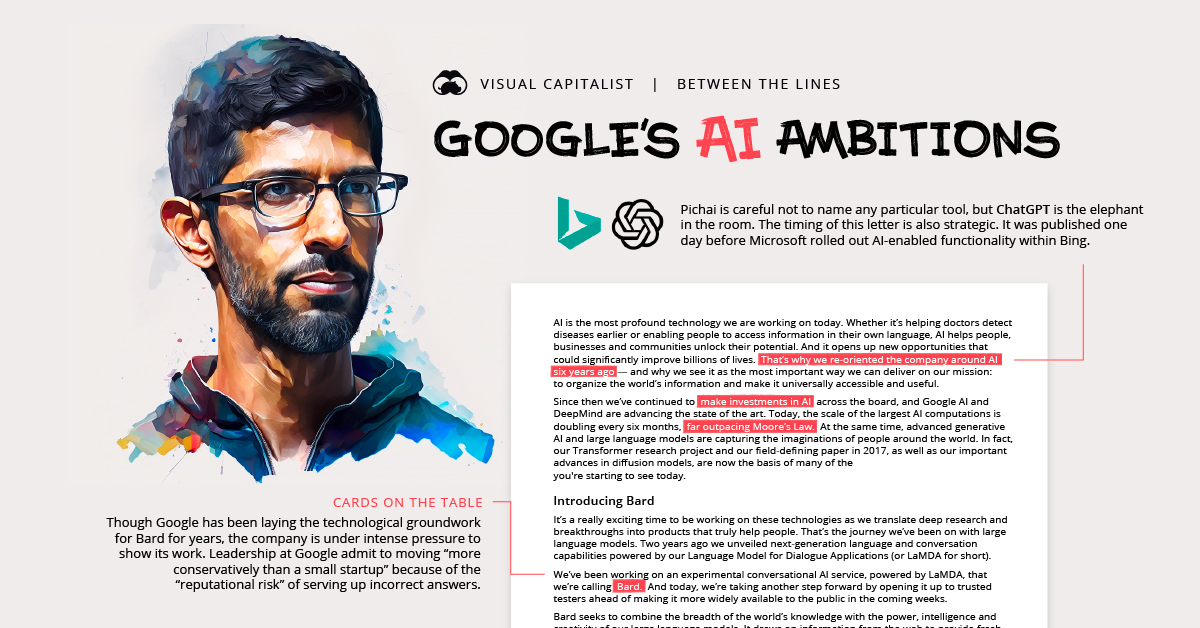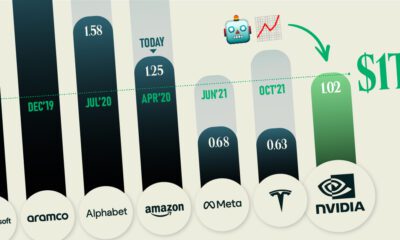AI
Decoding Google’s AI Ambitions (and Anxiety)
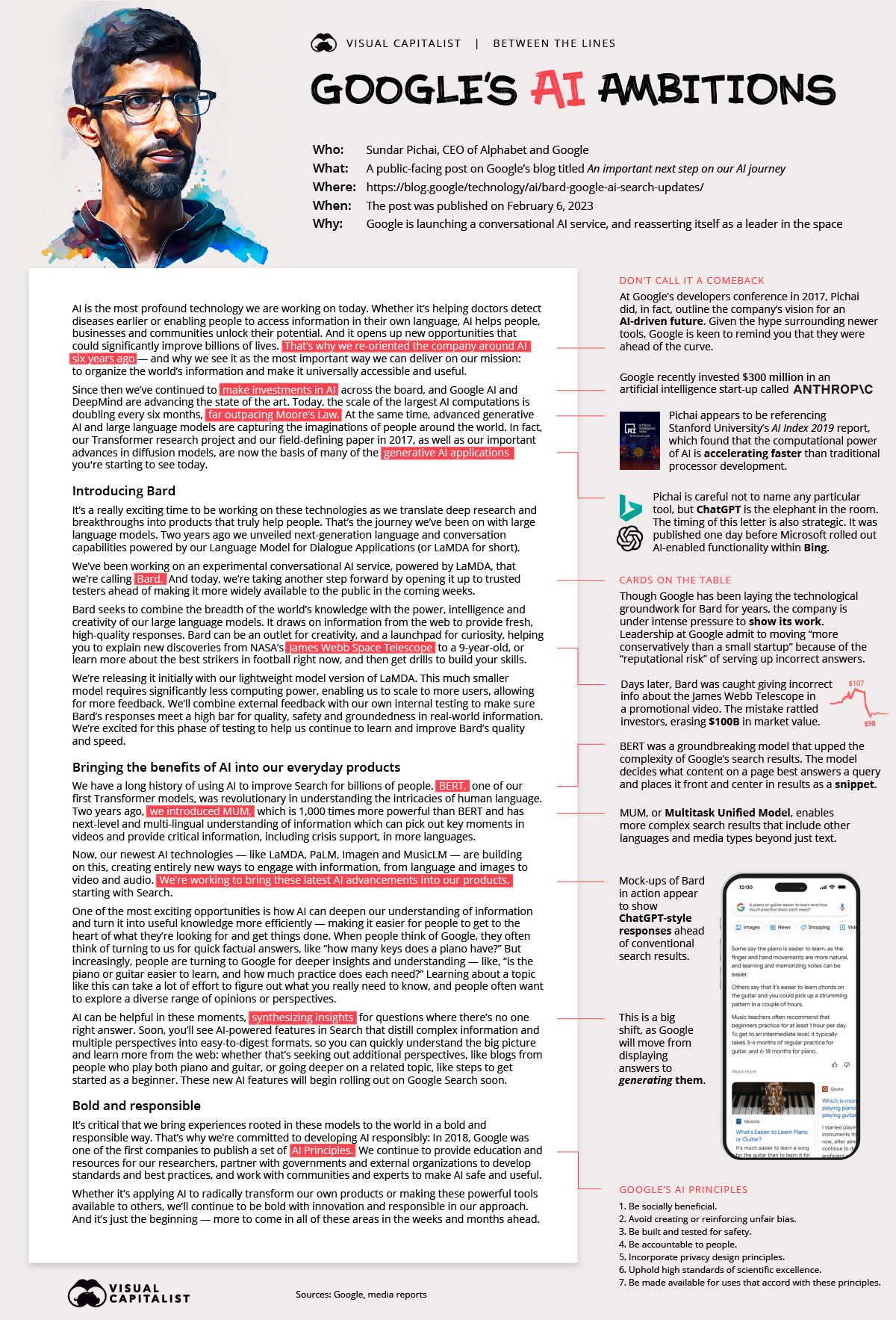
Decoding Google’s AI Ambitions (and Anxiety)
Anyone who’s experimented with ChatGPT can get a sense of the potential of generative AI—even in the technology’s earliest stages.
The hype around AI was rising throughout 2022, and has reached a fever pitch today.

We’ve seen hype cycles swell around specific technologies before. Blockchain, Metaverse, NFTs, the list goes on. It remains to be seen what tangible value is created after the heat dies down, but in the meantime, some of the world’s biggest companies are taking it very seriously.
Google—which internally reoriented itself around AI years ago—is at the forefront of this movement, so the recent letter published by Google CEO Sundar Pichai is consequential.
After all, billions of people use Google Search to learn about the world, and Alphabet is one of the world’s most valuable, powerful tech companies. But before we “read between the lines” of the letter, it’s worth revisiting the larger context that this letter addresses.
OpenAI Has Entered The Chat
Artificial intelligence has been chalking up a number of wins in recent months, but it was DALL-E Mini and ChatGPT that really allowed generative AI to burst into the public consciousness. In fact, ChatGPT became so popular in a short amount of time, that Google declared an internal “code red” to address the issue. Leaders at Google were well aware of the disruptive power of conversational AI because they were already testing their own models internally.
Microsoft recognized the potential as well, and invested $10 billion in OpenAI, which runs ChatGPT as well as a number of other publicly-accessible AI tools. Microsoft’s intention was to bring the magic of ChatGPT over to their Bing search engine—and perhaps steal market share away from Google.
This sets the stage for what we’re seeing today. Essentially every big tech firm is singing AI’s praises, and Microsoft and Google appear to be entering into an AI race.
The AI Race is Heating Up
If there were any questions about how seriously Google was taking Microsoft’s new partnership with OpenAI, recent messaging should remove all doubt. The letter above, by Sundar Pichai speaks volumes while never straying far from official talking points. First, here is the high-level messaging in Pichai’s letter:
- Google has already been in the AI game for years now
- Bard is going to make Google search more ChatGPT-like
- Google is only late to the party because they’ve been careful
On this last point: a message from the CEO, which reaffirms the company’s commitment to AI would normally coincide with a product launch, not one that will be released to the public “in the coming weeks”. This messaging highlights a key barrier that Google is facing. Fearing the “reputational damage” that could come from rolling products out prematurely, the company has been forced to move slower than the market now expects.
Google has already endured a painful misstep after reporters discovered an incorrect answer in a promotional video touting the conversational AI service, Bard. This simple mistake cost Alphabet $100 billion in market value—demonstrating how high the stakes are now that Big Tech’s AI progress is under the microscope.
The timing of this letter is also very telling. The letter was published the day before Bing rolled out new AI-enabled features to the public.
Let the jockeying for position begin.
Nobody Wants to be Left Behind
Google and Microsoft may be the biggest players battling it out in the AI space, but there are indicators all over that AI represents a massive technological shift that will impact a number of industries. From Fiverr’s “Open Letter to AI” to Baidu’s recent AI chatbot announcement, it seems that every day brings fresh news that fuels AI hype.
One thing’s for sure: AI will be integrated into digital tools in more noticeable ways. And for better or worse, we’ll all be participating the experiment.
AI
Mapped: Global Sentiment on AI
This infographic shows public perception of AI all over the globe and how this sentiment is affected by where you live.
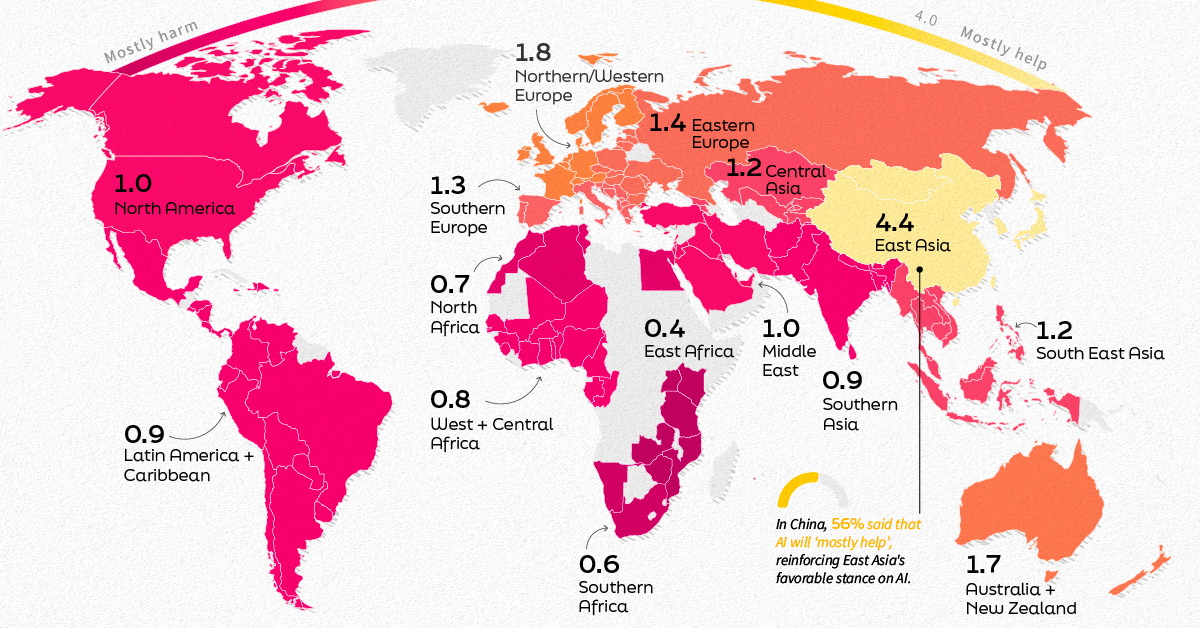
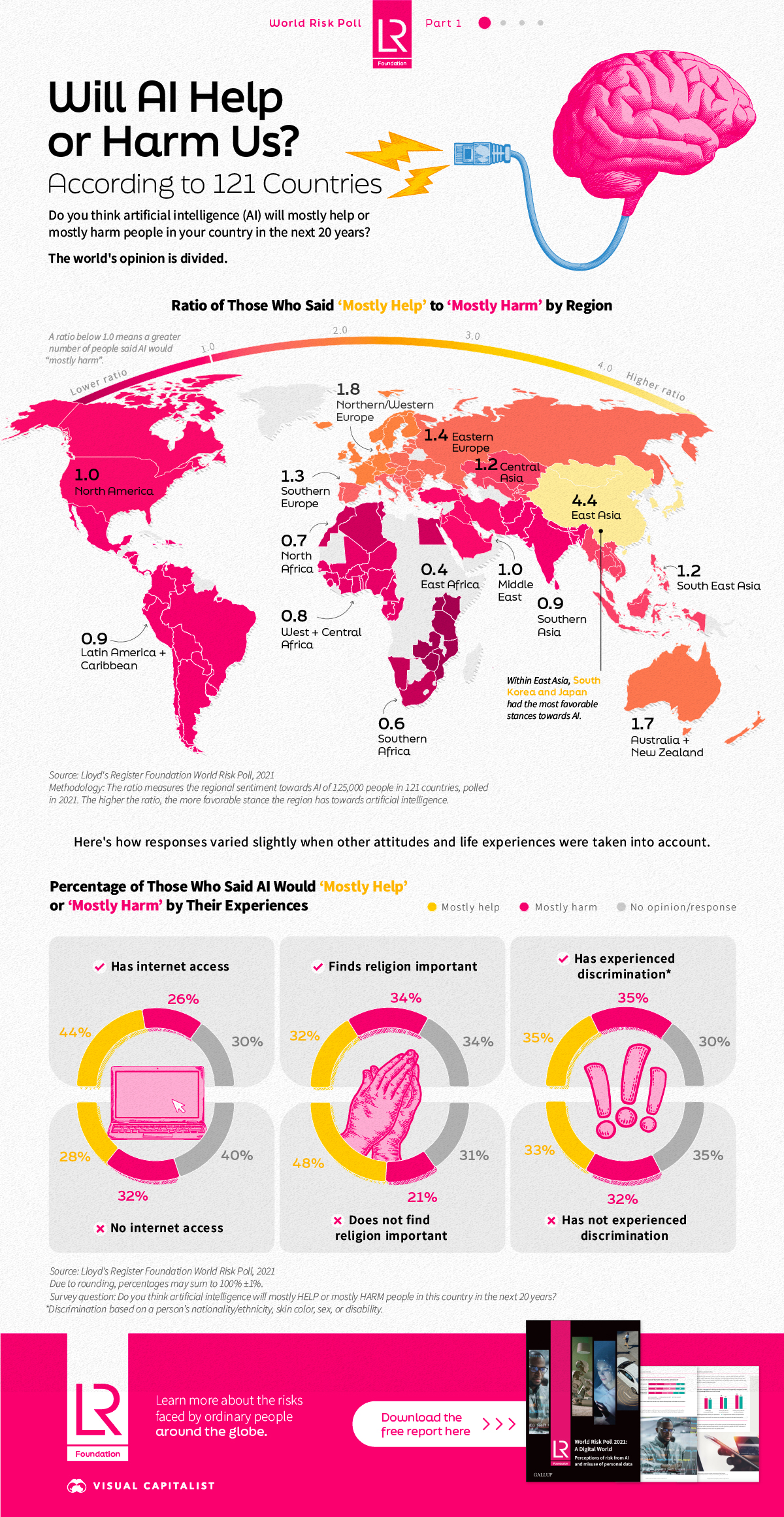
Global Sentiment on AI
Artificial intelligence (AI) has become a revolutionary force with the potential to transform many aspects of our daily lives. So understanding how the average person feels about this technology is essential as it integrates further into society.
In this graphic sponsored by Lloyd’s Register Foundation, we explore the findings of the World Risk Poll 2021: A Digital World.
The World’s Opinion is Divided
In the poll, which had 125,000 respondents in 121 countries, people were asked if AI would ‘mostly help’ or it would ‘mostly hurt‘ people in their home country over the next 20 years.
We’ve looked at the ratio of these responses below.
A higher ratio above 1.0 indicates that more people think AI could ‘mostly help’, while a ratio below 1.0 suggests that the population has more skepticism towards the technology.
Globally, the average ratio is 1.4, but significant differences can be seen when looking at each individual region.
| Region | Ratio |
|---|---|
| East Asia | 4.4 |
| Northern/Western Europe | 1.8 |
| Australia and New Zealand | 1.7 |
| Eastern Europe | 1.4 |
| Southern Europe | 1.3 |
| Central Asia | 1.2 |
| South East Asia | 1.2 |
| Middle East | 1.0 |
| North America | 1.0 |
| Latin America & Caribbean | 0.9 |
| South Asia | 0.9 |
| Central/Western Africa | 0.8 |
| North Africa | 0.7 |
| Southern Africa | 0.6 |
| Eastern Africa | 0.4 |
Notably, public opinion among the biggest economies appears split.
When we dug into the data, we saw that the U.S. showed skepticism towards AI with a ratio of 0.9. In this case, the potential loss of jobs could possibly be the leading cause of apprehension.
On the other hand, China expressed a ratio of 4.5, meaning for every 1 respondent that believes AI will ‘mostly harm’, 4.5 said AI would ‘mostly help’.
Why is AI So Polarizing?
AI has always been a divisive subject, and even the media can’t settle on whether AI is akin to the chaotic and malevolent Ultron or the caring and cat-obsessed Lt. Cmdr Data.
Consequently, it’s not just a person’s nationality or media consumption that impacts their stance on AI. A person’s life experience may also play a role in their perception of AI, more notably when it comes to religious views or access to the internet:
| View | Refused/Don't Know (%) | Neither (%) | Don’t Have Opinion (%) | Mostly Harm (%) | Mostly Help (%) |
|---|---|---|---|---|---|
| Has Access to the Internet | 5% | 3% | 22% | 26% | 44% |
| Do Not Have Access to the Internet | 15% | 2% | 23% | 32% | 28% |
| Religion is Important | 9% | 1% | 24% | 34% | 32% |
| Religion is Not Important | 7% | 4% | 20% | 21% | 48% |
| Has Experienced Discrimination | 6% | 3% | 21% | 35% | 35% |
| Has Not Experienced Discrimination | 9% | 2% | 24% | 32% | 33% |
Artificial intelligence has many philosophical ramifications, so it’s no surprise that only 32% of those who consider religion important believe AI will help. Conversely, 48% of non-religious people believe AI will ‘mostly help’.
In 16 countries, the percentage of people who say AI will ‘mostly harm’ was higher among those who had experienced discrimination based on their race/nationality, skin color, or sex, compared to those who had not. Notably, these include three Northern European countries where overall perceptions of AI are among the most positive in the world: Norway, Denmark, and Sweden.
An Uncertain Future
Even though 39% of global respondents believe AI will ‘mostly help’ in the next 20 years, only 27% of those people believe they would feel comfortable behind the wheel of a self-driving car. This suggests that while people may be ready for AI as a tool, they may not be ready for it to control large parts of their life.
With this in mind, understanding public opinion is crucial for policymakers and industry leaders to then shape the development and deployment of AI technologies in a manner that addresses these concerns.
Lloyd’s Register Foundation has created the World Risk Poll 2021 to help engineer a safer world, but the scope of this study goes beyond AI and personal data. In part two of this series, we’ll explore the World Risk Poll 2021: Safe At Work and unearth some startling trends regarding workplace harassment.

Learn more about the risks faced by ordinary people around the globe. Download the free report here.

-
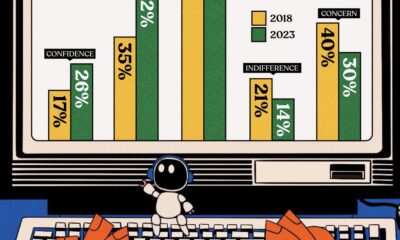
 Automation1 week ago
Automation1 week agoCharted: Changing Sentiments Towards AI in the Workplace
Opinions about using AI in the workplace have undergone a transformation from 2018, and so have the AI tools themselves.
-
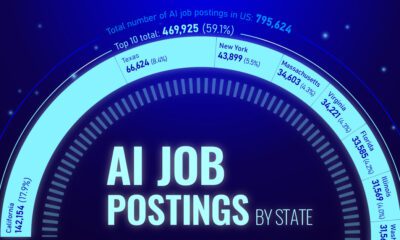
 AI2 months ago
AI2 months agoVisualizing the Top U.S. States for AI Jobs
Nearly 800,000 AI jobs were posted in the U.S. throughout 2022. View this graphic to see a breakdown by state.
-
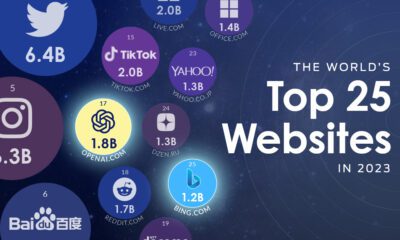
 AI2 months ago
AI2 months agoRanked: The World’s Top 25 Websites in 2023
OpenAI is now one of the world’s top websites, rapidly approaching the level of traffic received by TikTok and Amazon.
-
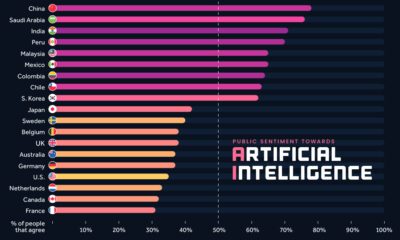
 Technology2 months ago
Technology2 months agoVisualizing Global Attitudes Towards AI
We visualize survey results from over 19,000 adults across 28 countries to see how attitudes towards AI differ around the world.
-
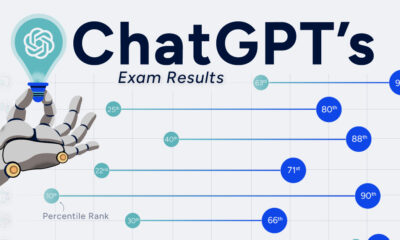
 Technology3 months ago
Technology3 months agoHow Smart is ChatGPT?
We visualize the performance of ChatGPT in various professional and academic exams, highlighting the improvements of GPT-4 over GPT-3.5.
-

 AI5 months ago
AI5 months agoDecoding Google’s AI Ambitions (and Anxiety)
In a recent letter, Sundar Pichai reveals more than meets the eye. Here we read between the lines to provide more context into Google’s position on…
-

 Markets2 weeks ago
Markets2 weeks agoVisualizing 1 Billion Square Feet of Empty Office Space
-
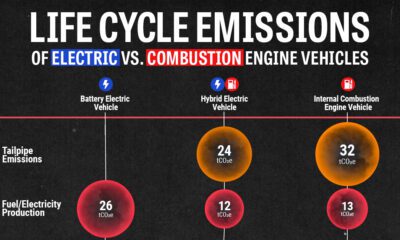
 Energy4 weeks ago
Energy4 weeks agoLife Cycle Emissions: EVs vs. Combustion Engine Vehicles
-

 Maps2 weeks ago
Maps2 weeks agoVintage Viz: The World’s Rivers and Lakes, Organized Neatly
-
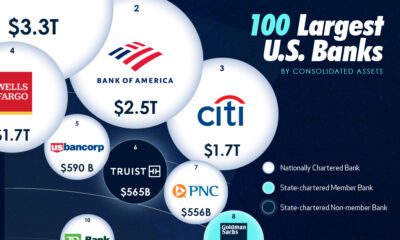
 United States3 weeks ago
United States3 weeks agoVisualized: The 100 Largest U.S. Banks by Consolidated Assets
-

 Automation1 week ago
Automation1 week agoCharted: Changing Sentiments Towards AI in the Workplace
-
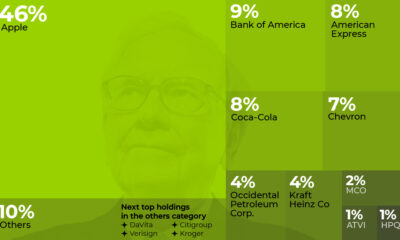
 VC+3 weeks ago
VC+3 weeks agoWhat are Top Investment Managers Holding in Their Portfolios?
-
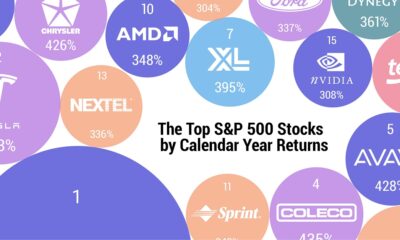
 Markets1 week ago
Markets1 week agoThe 50 Best One-Year Returns on the S&P 500 (1980-2022)
-
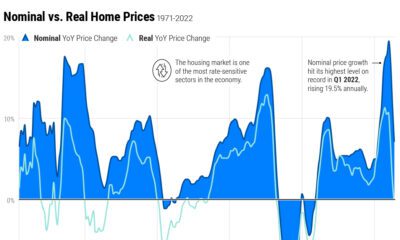
 United States3 weeks ago
United States3 weeks agoChart: U.S. Home Price Growth Over 50 Years




